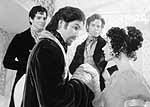 |
‘Count’
book tops movie An innocent man is betrayed and framed for murder, he is sent to the most unimaginable prison where everybody is “innocent,” his true love finds herself in the arms of another, and after getting out of jail, he seeks hidden treasure.
Sound a little like “The Shawshank Redemption?” Guess again. Alexandre Dumas’ acclaimed novel has once again come to the big screen, this time employing a fresh-faced cast of talented actors and a script fairly close to the original story of “The Count of Monte Cristo.” For those who enjoy doling out their money and time for two hours of action, romance, drama and a small helping of emotionally shallow entertainment, this film should be on the top of Friday’s to do list. For others, “The Count of Monte Cristo” may not sit high on the scale of movie greatness, but it is worth watching just the same. Because Dumas may just be a pejorative term to some, a brief synopsis of this suspenseful adventure is probably in line. Edmund Dantes (Jim Caviezel) is a young nobody’s son who has everything his friend Fernand Mondego (Guy Pearce) wants for himself: a beautiful fiancé (Dagmara Domincziyk), one of the highest ranks in a shipping company and a future filled with promise and happiness. Not being able to stand his jealousy for Dantes, Mondego betrays his friend, who in turn is sent to an infamous island prison to spend the rest of his life. With the help of fellow inmate Abbe Faria (Richard Harris), Dantes becomes an educated man, escapes prison after 13 years and transforms himself into the wealthy Count of Monte Cristo. Now, only one thing matters in Dantes’ life: Getting revenge. The costuming for “The Count of Monte Cristo” (created by designer Tom Rand) is probably the film’s best feature, allowing dress to perfectly symbolize each character at different times of their lives. In many ways, it seems that costuming tells a lot of the story, especially when looking at the changes made after Dantes’ escape. The acting is mostly impressive, with the exception of a few minor disappointments from Dantes’ sidekick Jacopo (Luis Guzman) and Mondego’s son Albert (Henry Cavill), who both seemed phony at a few points during the film. Because most of “The Count of Monte Cristo” was shot in Ireland, the scenery is beautiful and appropriately dreamlike, as if the audience is seeing a creation of the author himself. All in all, this movie presents an entertaining story that is both captivating and enjoyable. But if one expects “The Count of Monte Cristo” to have any kind of lasting affect on viewers, he or she will be sorely disappointed. Emily
Ward |
|||
|
TCU Daily Skiff © 2002 |
||||


